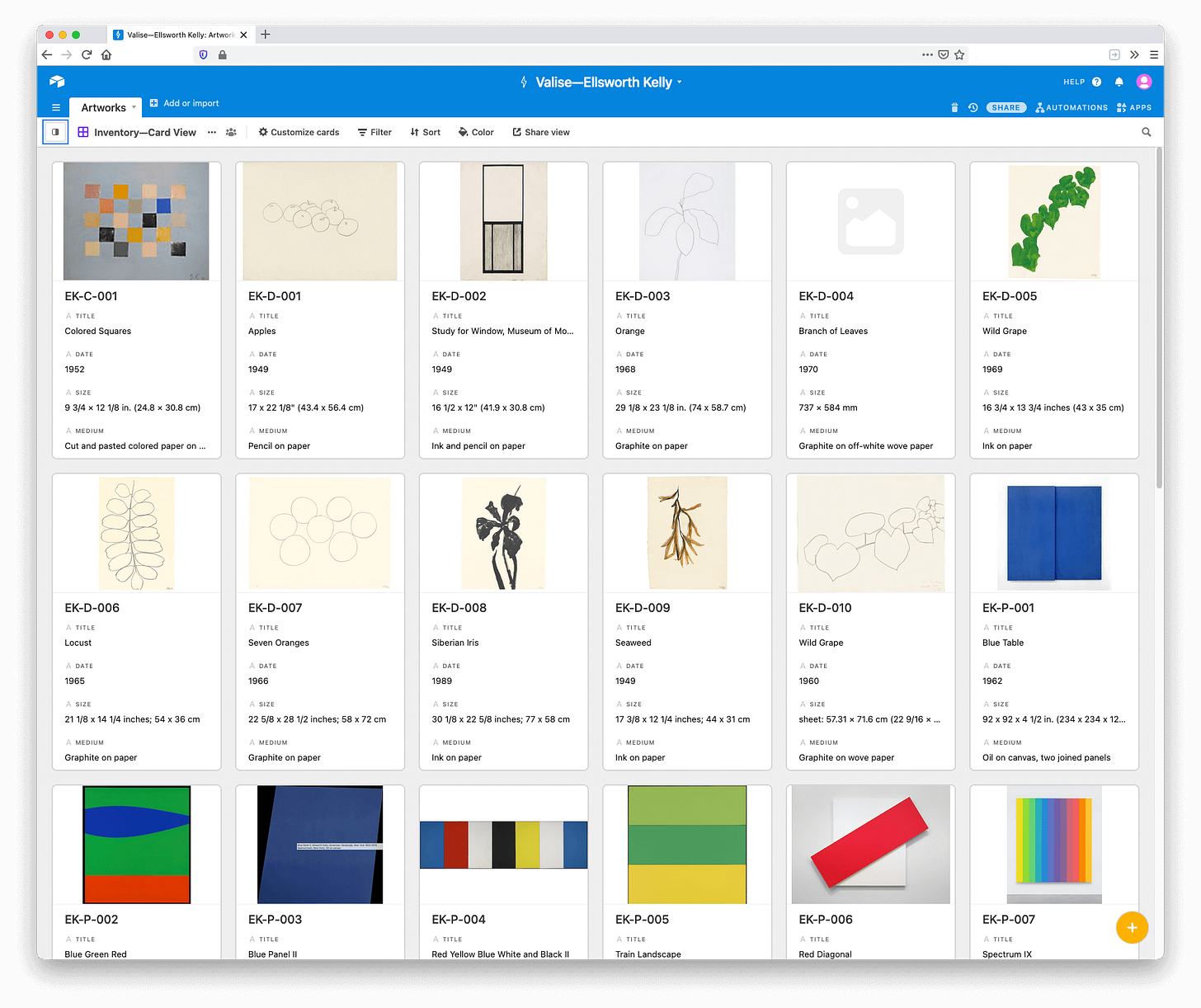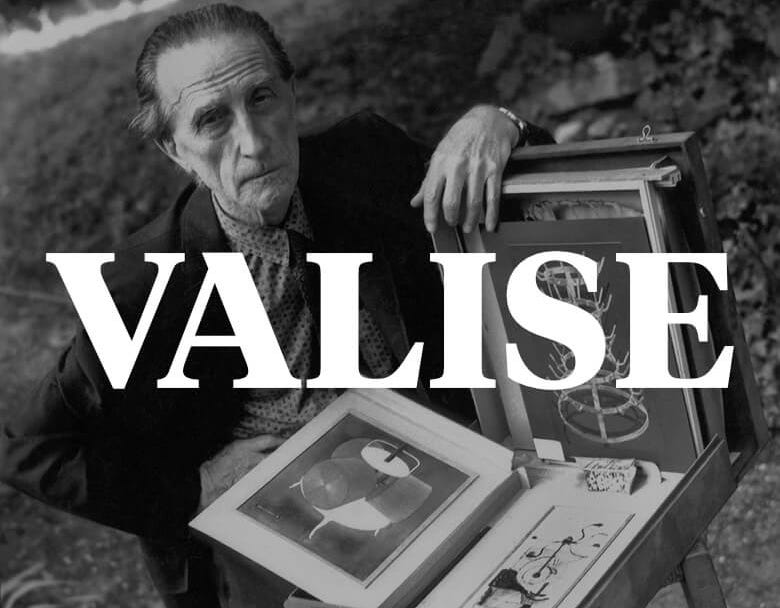There’s a romantic notion of what it means to be an artist that includes long nights at the studio, glamorous openings, and doesn’t include spreadsheets and emails. The reality differs: so much of being a successful artist depends on staying on top of business dealings, organization, and keeping track of contacts. Enter Valise, a free cloud-based database made for artists created by Brian Sholis, a strategist, editor, and writer based in Toronto.
Named after Marcel Duchamp, Valise offers artists a robust tool to keep track of almost every conceivable metric in regards to their studio. Hosted on Airtable, the database allows users to filter categories and easily share only certain information with curators or collectors inquiring about their work. It also allows artists to track where a work of art winds up, which is helpful if the work is ever requested to be part of a show.
On a more philosophical bent, Valise provides artists agency over their own information and hints at a shift away from the gallery-first model that has permeated the art world. As Sholis writes:
Managing a studio’s inventory is often the most difficult and time-consuming of these challenges. In speaking about this with artists, I have discovered that many do not own their data: once they establish a relationship with a gallery, they offload the cataloguing and tracking of their artworks to that gallery in order to concentrate on making new work. I use the phrase own their data for its resonance with social-media commentary. Many journalists, tech critics, and nonprofit organizations advocate owning your data to enhance your privacy and ensure it isn’t lost when a service is changed or disabled. I believe it’s imperative for artists to own their data, too
Read our interview with Sholis about Valise below:
Tatum Dooley: What was your inspiration for starting this program?
Brian Sholis: I have spent the past few years taking the skills and experience that I have from arts-administration work and helping my partner Julia [Dault] with the administrative side of her studio. She is fortunately successful enough that artworks leave the studio and go to different places and there are consignments to deal with. So, I built a database that keeps track of her artworks. I then thought, We have this great tool, it's free for us to operate because it fits within the free plan of [Airtable], why don't I share it with everyone else?
TD: What is Airtable?
BS: Airtable is a cloud-based software program that’s like Excel or Google Sheets on steroids. It looks like a spreadsheet, but on the back end, there's a pretty powerful relational database. That means it's not just for numbers and texts. You can add images or links to other files; it allows you to create a pretty robust way of tracking all the information about your studio. The one I built for Julia has things like production costs, framing, a PDF attachment for receipts, a field for what date the piece was made, etc. It becomes a one-stop shop for all of the information needed to run your studio. The other thing is that, because it's web-based, you can create and share different views onto the database. So, you can filter it and say, “[Give me] only the artworks that are made in 2021,” or “only the artworks that are consigned to a certain gallery.” You’ll see only that information and then you can share it with other people. For example, if a curator wants to do an exhibition, you can show them only the works you are considering including. Or if you need to see what has been sold, but you haven't yet been paid for, you can make a filter for that.
TD: If you were talking to an emerging artist who hasn't thought about keeping all of this information organized, how would you advocate for keeping track of things like production costs?
BS: There are two parts to it. As your practice develops it can become very complex, in the sense that there are lots of different pieces of information. And if you don't keep track of them, your life becomes a lot more difficult. If you're trying to figure out how to split payments with a gallery, if you're trying to figure out what's available and what's not, or if you're trying to figure out what you're keeping in your own collection and what you're letting go out into the world, it's much easier to have [that information] in one centralized repository than it is to have it in 10 different folders on your Dropbox and a couple of spreadsheets. This is one tool that makes your day-to-day life a lot easier. Secondly, and this is also important, any relationship that an emerging artist might develop with a gallery has no guarantee of longevity. If you offload the recording of important information to the gallery, if the relationship ends or anything changes, there’s no guarantee you'll be able to get that information back. Therefore, there’s a kind of power and authority over your work you don’t want to offload onto other parties.
TD: I wonder if you think that there has been a shift in the art world in recent years where artists are realizing that they need to take control of some of these things? Or even that there are more artists working independently from galleries that need to learn this business side.
BS: I think both those things are true. Perhaps when times are good, it's okay to offload your information and agency over to somebody. You know they’ll pick up the phone when you call. But if capitalism teaches us one thing, it’s that good periods do not last forever; there are downturns. Maybe [the gallery model] is increasingly outdated, one that's fracturing under its own weight, given all the things that are happening in the world. So, there are going to be many more examples of creative practices that are entirely independent, or that operate on a kind of contractor model. And so, again, having access to and dominion over your own information makes all that much more possible.
TD: I'm curious, how did you come to settle on the 30 or so categories in Valise?
BS: The answer to your question is that the entire thing is evolving. It's a living organism—it’s a bit funny to describe a database as that. As a need arises, you make a new column and a new filter for it. That way, you can search what you need to search. For anyone who wants to use this who doesn't need all its categories—let's say they never have any production costs because all they do is make drawings on paper with ballpoint ink—you can either hide or delete that [category]. When I give people access to it, they don't have to use the entire system that I’ve set up; they can use some portion of it that fits their needs.
TD: I think that's good for people to hear, I'm sure there are some people that were very intimidated by filling out all of the categories.
BS: This work is time-consuming. But attending to this side of your studio practice becomes a routine that becomes natural as you do it over time. As the system becomes more useful to you, the more you use it. I'm eager to help people set themselves up with Valise until it as much as I can. I'm completely willing to help people get set up.
To learn more about Valise, visit Sholis’s website and feel free to reach out to him for more information.
NEWS


EVENT: Thursday, April 22 at 6PM—Nia Centre’s Digital Launch: the cut, the tear, the remix: contemporary collage and Black futures
Police release photos of suspect after Inuvialuk art vandalized at Vancouver Art Gallery the globe and mail
Le jardin émaillé de Marie-Michelle Deschamps vie des arts
The Winners of the New Generation Photography Award 2021 national gallery of canada
TODAY: Watch four free films from TIFF’s survey on “Politics, Protest, and Activism,” including, Angry Inuk and Antigone.






